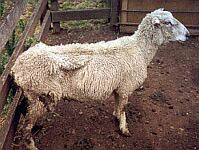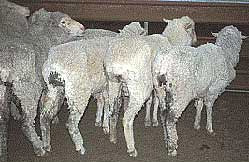Ovine Johne's Disease (OJD)
Ovine Johnes disease (OJD) is caused by infection with the bacteria, Mycobacterium paratuberculosis.

OJD is a chronic infection of the bowel. This causes the lining of the bowel to thicken and reduces the absorption of food. Affected sheep show severe wasting. Chronic scouring may occur. Sheep will eat and drink normally until they are too weak to graze. There is no treatment for OJD.
The classic sign of the disease in a sheep flock is a distinct tail of the mob, comprising sheep in poorer condition than the rest of the mob.
Most sheep do not show signs of illness for a long time after becoming infected. Many infected sheep carry the bacteria in the gut and spread the disease prior to showing obvious signs of disease.
Notification of OJD

The Livestock Disease Control Act (1994) designates certain diseases, including OJD, to be notifiable.
This means that both confirmed and suspected cases of OJD must be reported to Agriculture Victoria animal health staff within 7 days of identification.
Persons responsible for notification can be:
- owner
- custodian of livestock
- vet
- meat inspector or meat processing facility operator
- owner of any land upon which stock are present
- knackery operator
- stock agent
- or any other person dealing with livestock or livestock products.
How sheep are infected with OJD
Sheep can become infected at any age, but young sheep are more susceptible. Susceptibility can also be influenced by stress and the presence of other diseases.
Infected sheep shed bacteria in their manure and contaminate the environment before showing signs of OJD. Other sheep become infected when they consume food or water contaminated with this manure.
The bacteria that cause OJD can survive 12 months or more in a favourable environment, such as sheep campsites and swampy or wetter areas of the farm.
Lambs can also become infected while in the ewe's uterus. However, this is more likely to occur when the ewe is showing signs of OJD.
Treatment for OJD
While there is no treatment for OJD, vaccination against this disease has proven to be highly effective.
Vaccinating your sheep
Vaccination:
- delays shedding of bacteria from infected sheep
- decreases the amount of shedding from infected sheep
- decreases death rates in flocks.
Why vaccinate?
Sheep owners may choose to vaccinate their flock to:
- help control OJD if the flock is infected
- help prevent the introduction of OJD into an unaffected flock
- provide extra assurance to purchasers of sheep, including rams, that they are at lower risk of being infected
Who should vaccinate?
Vaccination is recommended for most infected flocks and any flock at risk of infection. Owners of infected flocks should discuss the strategic use of vaccines with their veterinarian. It should include:
- the type of sheep enterprise they run (wool, meat, stud)
- how often sheep are introduced into the flock
- the number of different source flocks sheep are purchased from
- whether they sell non-slaughter sheep
- whether OJD has been detected in their district
- the condition of boundary fencing
- local topography and drainage onto their property
- the cost of the vaccine
- safety issues associated with vaccine use.
SheepMAP flocks are those that have been tested with negative results and have management in place to assist in preventing the introduction of OJD into their flock. Many of these flocks are also choosing to vaccinate in order to provide extra assurance that OJD is not present in their flock.
How to vaccinate your sheep
It is recommended that sheep are vaccinated as lambs, between 4 to 16 weeks of age.
Sheep over 16 weeks of age can also be vaccinated. However, it already exposed to the bacteria, vaccination may not be as effective.
Accidental self-injection with Gudair™ vaccine may result in side effects and a severe inflammatory reaction in people. To reduce the risk of accidental self-injection, sheep should be suitably restrained.
The product leaflet should be read carefully before use.
Where to obtain a vaccine
Gudair™ vaccine can be obtained from vets and rural merchandisers who are approved to sell the vaccine.
National Sheep Health Declaration
The National Sheep Health Declaration (SHD) is a formal document that accompanies non-slaughter sheep when they are sold. It does not replace a national vendor declaration (NVD) but should be used in conjunction with a NVD.
The SHD indicates the health status of the sheep being sold and is signed by the vendor. It contains sections relating to the OJD, footrot, lice and ovine brucellosis history of the flock. It is an offence to make a false declaration on this statement.
It is not mandatory to complete a SHD when selling sheep within Victoria. However, it is strongly recommended that you request a SHD from the vendor prior to purchasing sheep. It may also be mandatory to complete a SHD prior to moving sheep interstate.
To download the National Sheep Health Declaration, visit Farm biosecurity declarations.
Further information
For further information about ovine Johne's disease, visit the National Johne's Disease Program website.